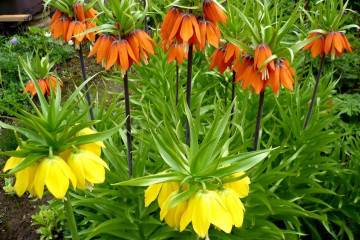When to plant tulips
Content:
The abundance of tulip sellers in the spring leads to the idea that they grow in everyone and in large quantities. However, not all so simple. In order for tulips to bloom and give good offspring, they need to pay a lot of attention, especially when storing the bulbs off-season.
When to plant tulip bulbs
It is generally accepted that tulip bulbs should be planted in the fall. Then multi-colored bright buds will appear with the onset of warmth.
The optimum temperature for starting work in the garden is from +7 to +10 ° C. This weather occurs in late September - early October. Late planting of bulbs is also possible - in November, in which case the soil is covered with foliage or spruce branches for insulation.
Bulbs are planted in the ground - modified shoots. It is to them that the most attention is paid.
If in the fall there was not enough time to plant tulips in the country or there were no bulbs available, then the planting can be postponed to the spring time when the snow melts. The air temperature for spring planting should be stable at + 8-10 ° С.
General landing dates: table
The planting time for tulip bulbs depends on the weather conditions in a particular region. When to plant tulips, depending on the climate, is presented in the table.
| Region | Planting period |
| Belarus | End of September - beginning of October |
| Siberia | Late August - mid September |
| Northern part of the Urals | Until September 15 |
| Southern part of the Urals | Until October 10 |
| Middle zone of Russia | End of September |
| South of Russia | Mid September - mid October |
| Leningrad region | End of September - mid |
| Moscow and Moscow region | Mid September - mid October |
All numbers are indicative, depending on the weather at a given time and on the selected tulip variety.
Bulb rooting takes place within 1.5 months, so you need to understand in advance when you can plant tulips in the fall. Late planting is fraught with freezing of the material until it takes root. Before the first frost, the plant should form a root lobe that will feed the bulb throughout the winter season.
If you plant the bulb too early, growth processes are activated before the onset of frost, and in winter such a plant will not be able to survive.
Why you need to plant tulips in autumn
The advantage of autumn planting is that the bulb has time to build up a strong root system until spring, which fully saturates the planting material with nutrients from the soil. During frosts, tulips undergo hardening, so the flowering will be more magnificent, and the colors of the petals are bright.
What are the disadvantages of autumn planting: strict adherence to deadlines, freezing of material, damage to bulbs by wintering parasites and rodents. All of this can be avoided by planting flowers in a greenhouse.
Most cultivars can be grown home and bred on windowsill in plastic pots. The same preparation requirements apply to the bulbs.
How and where to store bulbs until autumn planting
Storage requirements for planting material:
- compliance with the summer temperature regime of 23-25 ° С;
- a change in the temperature regime in August up to 20 ° С;
- lowering the air temperature to 15 ° C a week before gardening;
- storage in a dry place, since moisture contributes to the development of fungal and bacterial diseases;
- do not dry out the air so that the bulbs do not dry out and die;
- eliminate exposure to direct sunlight;
- provide air ventilation.
If it is not possible to provide ideal conditions for planting material, it is a good option to store the bulbs on the bottom shelf of the refrigerator. Before that, they are well dried and wrapped in newsprint.
Compliance with the temperature regime affects the setting of buds and the quality of future leaves. Otherwise, "blind buds" will appear, which, as a rule, will not be able to bloom.
Agricultural technique of planting tulips in autumn
If experienced gardeners talk about tulips, planting and care outdoors is identical to growing in special baskets. The quality of the soil and the depth of the material do not differ. The advantage of this method is the reduction in physical costs for gardening.
How to properly plant tulips for better flowering
How to grow tulips for abundant flowering? First of all, the planting material is sorted: they remove wilted or rotten bulbs, leaving only large and medium units. The better the bulb, the healthier the flower will be, the brighter and larger the bud. Also in the future it will give good offspring for further reproduction.
Future tulips are cleaned with a slightly pink solution of potassium permanganate, this eliminates germs and fungus. Further, the treatment is carried out with a growth stimulant, following the instructions on the package.
Soil preparation
The tulip bed is prepared in advance. Ash, mineral and organic fertilizers are applied to the selected place. To reduce costs, you can purchase a complex "for bulbous".
Then the grooves are covered with earth and leveled so that moisture does not accumulate in this place after precipitation. If the weather is dry, the soil is watered after 10 days.
The burial distance depends on the size of the future tulip, the height of the soil should be twice the diameter of the bulb. There must be enough space underground for the formation of "kids".
Seat selection
Tulips love bright light, so the site is chosen sunny, without drafts. The soil should be loose, preferably on a hill. The plant is destructively affected by stagnant moisture or underground waters passing nearby.
When and how to plant tulips outdoors in spring
Spring planting benefits:
- simultaneous planting of all ornamental plants on the site;
- the absence of the likelihood of death of bulbs during a cold winter;
- no need for special storage of bulbs.
At the same time, not everything is as simple as it seems at first glance. Tulips planted in spring often do not bloom, so they need to be pretreated and hardened.
Proper storage of bulbs for spring planting
Before growing tulips in the open field, the bulbs are sorted out and only large specimens (more than 3-4 cm) are left. Children up to 1 cm in diameter are definitely removed. Materials of different sizes and grades are stacked separately. The bulbs are peeled and washed in a pink solution of potassium permanganate. Tulips are dried in a shaded place where there is no risk of getting wet from precipitation.
A week later, the material is examined again, scales, embryonic bulbs, and remnants of stems are removed. After 2-3 days, the best specimens are sent for storage.
The selected dried material is laid out in boxes or other container in one layer. The bottom of the container and its walls should be mesh to provide air access. You can find special heat chambers on sale. Tulips can be hung in fabric bags, string bags, or nylon tights. Do not use cardboard boxes for storage.
To help the tulips bloom faster, you can put oven-baked forest soil or peat mixed with vermiculite at the bottom of the storage box. In winter, rooting will take place, but the air temperature in the basement will not allow the plant to grow.
It is not necessary to store planting material for breeding in a cellar or basement. This can even be done in a residential building or apartment. Choose a cool, dry place that is not affected by drafts and heat from the batteries. Each onion can be wrapped in dry sawdust and newspaper.
Preparing for planting tulips in spring
Growing tulips begins with choosing a sunny spot on the site. As soon as the snow melts, a bed is dug up, ash and rotted compost are laid in it. If the soil is heavy, it is diluted with loose soil and compost.
The day before planting, the bulbs are kept for one night on the bottom shelf of the refrigerator. On the day of planting, the peel is removed and soaked for half an hour in a solution of potassium permanganate or celandine broth.
Planting bulbs in the ground
The best time to plant tulips in spring is early April. Between the grooves for large bulbs, a distance of 30 cm is observed, for children - 15 cm. 3 cm of river sand is placed at the bottom of the groove. Before planting, the soil is watered with a pink solution of potassium permanganate.
How to plant tulips in the grooves? Large specimens are placed in the ground to a depth of 10-15 cm, smaller ones by 6 cm. After that, the soil is tamped and gently passed with a rake. Watering is carried out before and immediately after planting.
Tulips: care and cultivation after planting
Tulips will appear from the ground between mid-March and mid-April. If the plant was planted in the fall, after the snow melts, the mulch is removed; before that, there is no need to care for them.
How to grow healthy tulips? In the phase of active growth of tulips, they are carefully examined. Those bulbs that have not sprouted are dug up and destroyed to avoid contamination of plant diseases in the neighborhood.
Near the sprouts that appear, the soil is loosened so that more air can flow to the roots. Loosening is necessary throughout the entire period of growth and flowering, as well as after each watering or precipitation.
The frequency of watering increases during flowering, the soil should only be slightly moistened. At the same time, excess moisture is no less harmful than its lack. Waterlogging leads to cracks in the bulbs.
The first feeding is carried out in early spring, when the first shoots appear. For the formation of strong shoots, nitrogen must be added. Crystallin or nitroammophos plus trace elements are also suitable.
When the third leaf appears, additional, but not mandatory, feeding is carried out. Complex mineral fertilizer is applied to the soil.
To enjoy the process of growing tulips, you need to familiarize yourself with the theory. And having bought already hardened bulbs, even a novice grower will not have problems.





















